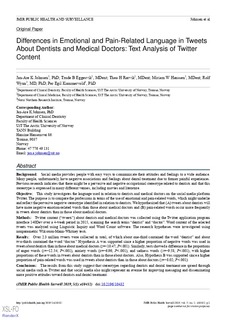| dc.contributor.author | Johnsen, Jan-Are Kolset | |
| dc.contributor.author | Eggesvik, Trude Benedikte | |
| dc.contributor.author | Rørvik, Thea Heyerdahl | |
| dc.contributor.author | Hansen, Miriam Wöhlert | |
| dc.contributor.author | Wynn, Rolf | |
| dc.contributor.author | Kummervold, Per Egil | |
| dc.date.accessioned | 2020-02-07T11:03:12Z | |
| dc.date.available | 2020-02-07T11:03:12Z | |
| dc.date.created | 2018-11-05T08:39:32Z | |
| dc.date.issued | 2019 | |
| dc.identifier.citation | JMIR Public Health and Surveillance. 2019, 5 (1), 1-9. | |
| dc.identifier.issn | 2369-2960 | |
| dc.identifier.uri | http://hdl.handle.net/11250/2640332 | |
| dc.description.abstract | Background:
Social media provides people with easy ways to communicate their attitudes and feelings to a wide audience. Many people, unfortunately, have negative associations and feelings about dental treatment due to former painful experiences. Previous research indicates that there might be a pervasive and negative occupational stereotype related to dentists and that this stereotype is expressed in many different venues, including movies and literature.
Objective:
This study investigates the language used in relation to dentists and medical doctors on the social media platform Twitter. The purpose is to compare the professions in terms of the use of emotional and pain-related words, which might underlie and reflect the pervasive negative stereotype identified in relation to dentists. We hypothesized that (A) tweets about dentists will have more negative emotion-related words than those about medical doctors and (B) pain-related words occur more frequently in tweets about dentists than in those about medical doctors.
Methods:
Twitter content (“tweets”) about dentists and medical doctors was collected using the Twitter application program interface 140Dev over a 4-week period in 2015, scanning the search terms “dentist” and “doctor”. Word content of the selected tweets was analyzed using Linguistic Inquiry and Word Count software. The research hypotheses were investigated using nonparametric Wilcoxon-Mann-Whitney tests.
Results:
Over 2.3 million tweets were collected in total, of which about one-third contained the word “dentist” and about two-thirds contained the word “doctor.” Hypothesis A was supported since a higher proportion of negative words was used in tweets about dentists than in those about medical doctors (z=−10.47; P<.001). Similarly, tests showed a difference in the proportions of anger words (z=−12.54; P<.001), anxiety words (z=−6.96; P<.001), and sadness words (z=−9.58; P<.001), with higher proportions of these words in tweets about dentists than in those about doctors. Also, Hypothesis B was supported since a higher proportion of pain-related words was used in tweets about dentists than in those about doctors (z=−8.02; P<.001).
Conclusions:
The results from this study suggest that stereotypes regarding dentists and dental treatment are spread through social media such as Twitter and that social media also might represent an avenue for improving messaging and disseminating more positive attitudes toward dentists and dental treatment. | |
| dc.language.iso | eng | |
| dc.rights | CC BY 4.0 | |
| dc.rights.uri | https://creativecommons.org/licenses/by/4.0/ | |
| dc.title | Differences in emotional and pain-related language in tweets about dentists and medical doctors: Text-analysis of Twitter content | |
| dc.type | Peer reviewed | |
| dc.type | Journal article | |
| dc.description.version | publishedVersion | |
| cristin.unitcode | 6002,1,0,0 | |
| cristin.unitname | Norut Northern Research Institute AS, teknologi | |
| cristin.ispublished | true | |
| cristin.fulltext | original | |
| cristin.qualitycode | 1 | |
| dc.identifier.doi | 10.2196/10432 | |
| dc.identifier.cristin | 1626877 | |
| dc.source.journal | JMIR Public Health and Surveillance | |
| dc.source.volume | 5 | |
| dc.source.issue | 1 | |
| dc.source.pagenumber | 1-9 | |

